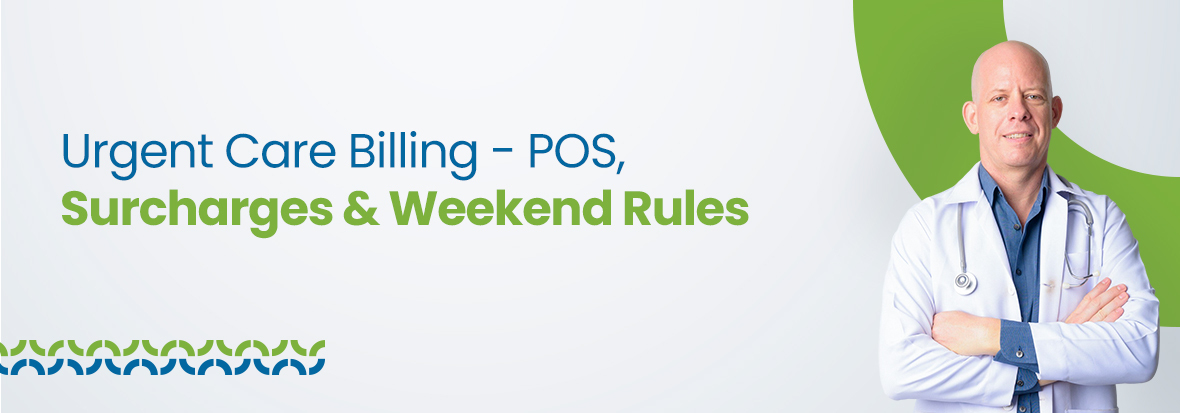The single biggest problem urgent care providers face is revenue leakage from preventable denials, most often caused by incorrect place of service (POS) coding, unsupported surcharges, and weak after-hours documentation. These errors drive rework, slow cash flow, confuse patients, and invite audits. These handful of mis-coded or poorly documented encounters can materially reduce monthly collections and create ongoing operational friction between clinical, front-desk, and billing teams, eroding overall urgent care reimbursement.
To address this issue, urgent care centers require a structured billing process that integrates documentation, coding, and payer rules. Start by confirming that each payer has your site credentialed, so the POS code on the claim matches the one in the contract file. During the visit, ensure timestamps, procedures, and any after-hours needs are fully documented to support modifiers and surcharges. Before sending claims, separate professional and facility charges correctly and run checks to identify potential POS mismatches or unsupported surcharges.
Place of Service (POS)
The Place of Service is a two-digit code reported on professional claims that indicates the physical setting where services were provided. Use the POS that accurately reflects the facility and how the service was delivered; for freestanding urgent care facility centers, POS 20 is the designated code and is distinct from office, outpatient hospital, or emergency department codes. Accurate urgent care POS selection is a first-line control to reduce denials.
Reporting the correct POS influences payer processing logic, patient cost-sharing, and whether facility fees or different contract terms apply. Always confirm whether your urgent care is credentialed and contracted with a payer as POS-20, POS-11 (office), or as part of a hospital outpatient (POS-22). Payer contract language and the tax ID/billing NPI setup determine how claims must be submitted and paid.
Operational Checklist for Assigning POS on Every Claim
When closing a visit and preparing the claim, follow these sequential checks in the chart and billing workspace.
- First, verify the physical location and how the site is registered with payers (e.g., standalone urgent care vs. hospital-affiliated outpatient department).
- Second, confirm whether the claim will include a facility component (UB-04) in addition to the professional component (CMS-1500/837P). If the site charges a facility fee, the facility claim must reflect the appropriate revenue code and POS.
- Third, match the billing NPI/Tax ID used to submit the service with the credentialed entity in each patient’s payer file; mismatches can trigger rejections or down-coding.
- Fourth, when in doubt, query the payer’s provider relations or the contract language before submission and document that verification in the practice’s billing notes. These four checks reduce POS conflicts, misapplied patient copays, and claim rejections.
Surcharges
Surcharges are incremental costs your clinic can impose to represent increased operational costs during certain periods or services (such as weekend surcharges, holiday surcharges, or late-night surcharges, triage surcharge, or facilities surcharge). Payers have not paid evenly across surcharges: most insurers pay after-hours expenses as part of the contracted amount or overtly forbid paying any additional surcharge.
Therefore, before billing a surcharge to insurance, you must
- Review the payer contract and policy for the specific surcharge type.
- Document clinical and operational justification in the chart (time/date, staffing level, any additional resources used).
- Obtain and retain patient acknowledgment where your policy shifts non-covered surcharges to patient responsibility.
If the insurer denies a surcharge, convert the denial reason into a patient statement only when your published financial policy and signed patient acknowledgement permit patient billing; otherwise, the write-off or appeal must be handled in accordance with the contract.
Need help streamlining POS and surcharge processes? Partner with experts who specialize in urgent care billing compliance.
Weekend Rules
Weekend and after-hours visits require precise timestamps and clinical justification. Document arrival time, start of service, procedure start and stop times where applicable, and discharge time. For visits that include both an E/M and a procedure (e.g., wound repair), determine whether the E/M was “significant and separately identifiable” from the procedure. In this case, add the modifier -25 to the E/M code and ensure that the note includes the additional history/exam/ medical decision-making to justify the separate billing.
In case of separate procedural services which are reported on the same day, suitable distinct-procedure modifiers (such as modifier 59 or one of the more specific XE/XS/XP/XU modifiers as allowed) are used when a different anatomic site, different session, different injury, etc., is established by the clinical circumstances. Always verify payer modifier policies since some payers either need specific documentation when submitting a claim, or conduct special reviews over the use of modifier-25 and modifier-59. If the payer anticipates such charges to be added to a patient’s balance over the weekend, ensure that they are captured in your intake scripts and financial consent procedures.
Documentation Standards that Support POS, Surcharges, and Weekend Rules
High-quality documentation is the single best control for audit defensibility. Every chart supporting an urgent care claim should include:
- Exact location (clinic name and address)
- Arrival and service timestamps
- Chief complaint and brief relevant history
- Focused exam findings tied to the complaint
- Diagnostic tests performed and their results
- Procedures with start/stop times and technique,
- Medications given/dispensed,
- Aftercare instructions
- A brief rationale for any after-hours or weekend needs.
If you apply modifier-25, include explicit language that a separate evaluation was required beyond the procedure (for example: “Patient presented with X; in addition to laceration repair, I performed a separate history/exam/medical decision-making for suspected infection/other problem.”).
Should charge a surcharge, include one line in the note about the cause of operation (e.g., staffing surge/physician on site due to late-night triage between 12:00-02:00 leading to weekend facility surcharge as per clinic policy), and cite the signed acknowledgement of the patient in case the surcharge can be billed to the patient. These particular expressions are concise and avoid initial rejections.
Separating Professional and Facility Components
When your urgent care operates under both a professional fee model and a facility fee model, prepare separate claim elements for each type of model. Submit the professional services (provider CPTs) on the CMS-1500/837P with the provider’s NPI, and submit any facility revenue codes/UB-04/837I lines under the facility’s billing NPI and tax ID. Use POS on the professional claim that accurately reflects the service location; on facility claims, ensure revenue codes, facility charges, and the facility’s taxonomy reflect the same incident.
If your urgent care is contracted as part of a hospital outpatient department, do not submit POS-20 on professional claims if the payer requires POS-22 for hospital-based outpatient services. Incorrect pairing of facility and professional POS will cause denials or incorrect patient copays. Maintain a mapping table (payer → required POS → facility NPI) for each major payer to automate correct claim population.
Common Coding and Operational Pitfalls
Many centers inadvertently create denials by:
- Using a POS that does not match the payer’s credentialing file.
- Appending modifier-25 without chart support.
- Billing surcharges without reviewing the contract or obtaining patient acknowledgement.
- Submitting facility and professional charges on the wrong claim type.
- Failing to record accurate timestamps.
Some mitigations include maintaining an updated payer mapping table, providing a one-line clinical justification when modifier-25 is used, obtaining signed financial consent for patient-billable surcharges, utilizing auto-scrubbing of claims to identify POS/modifier discrepancies, and training front-desk employees to record arrival/discharge times accurately.
Prevent common coding errors by leveraging automated claim scrubbing solutions.
Step-by-Step Workflow You Can Adopt
- Intake: Verify insurance, note how the payer files your site (POS expectation), and print/scan patient financial consent if a surcharge may apply.
- Clinical Encounter: Clinicians must record the arrival time, key history/exam, any procedures (with start/stop times), and provide a one-line justification for after-hours needs.
- Charge Entry: Assign POS per your payer mapping table, attach procedure and E/M codes, evaluate modifier requirements (-25 or distinct procedure modifiers), and flag any surcharges authorized by the payer or patient.
- Claim Scrub: Run edits for POS/contract mismatch, NCCI edits against modifier use, and missing timestamps or signatures.
- Submission and Tracking: Submit claims, route denials with a standardized packet for appeal within X business days, and track trends related to contracting.
Example Scenario
A patient presents on Sunday at 21:00 with a laceration. The clinic documents arrival at 20:45, examination at 21:00, local anesthesia and laceration repair from 21:15 to 21:35, and a separate complaint of fever requiring evaluation and decision-making to order an influenza test. The clinic verifies the payer allows POS-20 and notes the clinic’s patient agreement for weekend surcharge.
Charge entry should set POS-20 on the professional claim, report the laceration repair CPT, and report the E/M with modifier-25 appended (because the evaluation for fever was separate and required medical decision-making). Include the facility line if applicable, and include the weekend surcharge, as per the clinic’s policy, as a separate line only if the payer permits it; otherwise, bill the patient after insurer adjudication with the signed consent. Save the clinical phrases that justify the modifier-25 and the signed financial consent in the chart to support any audit or appeal.
Training, Monitoring, and Continuous Improvement
Make these changes sustainable by creating short training modules for front-desk, clinical, and billing staff that focus on:
- POS identification and payer file checks,
- What constitutes a significant, separately identifiable E/M (modifier-25 use),
- How to document procedural distinctness (modifier-59 family), and
- The clinic’s surcharge policy and patient consent process.
Monitor key KPIs weekly for 60–90 days following the implementation of changes. POS mismatch denials, modifier-25 denials, surcharge denials, and time-to-appeal success rate. Use denial trend data to prioritize payer re-education or contracting changes.
Conclusion
In conclusion, effective urgent care billing relies on aligning POS accuracy, thorough documentation, and payer compliance within a structured process. By implementing disciplined workflows, verifying credentialing data, capturing precise clinical details, timeframes, and applying modifiers appropriately. Separating professional and facility charges and managing surcharges in accordance with contracts and patient consents, providers can significantly reduce preventable denials.
Long-term success also requires employee training, pre-bill control automation, and a standardized appeals policy to resolve issues with payers in an effective way. In regular applications, these measures not only protect revenue but also fast-track reimbursements, enforce compliance, and improve operational performance throughout the urgent care environment.

